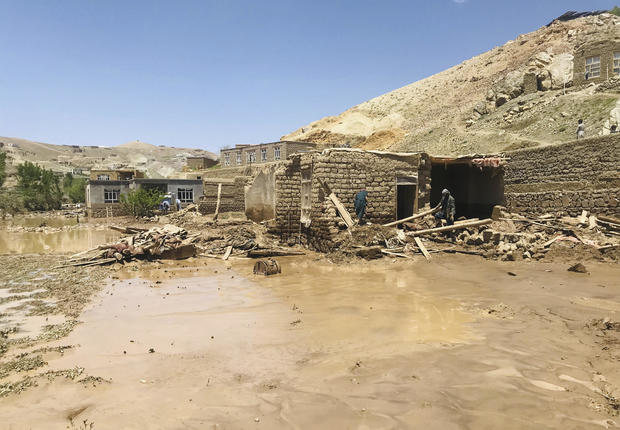Asia
From climate change to “foreign conspiracy”; Recent floods left 60 dead in Afghanistan

The devastating floods in the past few days have taken the lives of many people and affected huge financial losses in a number of provinces across Afghanistan.
The destruction of public roads, demolishing of agricultural crops and the loss of thousands of citizens of the country are other consequences of the storm and heavy rains in the provinces of Nangarhar, Kunar, Panjshir, Kapisa and Maidan Wardak.
The Taliban have confirmed that 47 people were killed and more than 350 others were injured as a result of floods and severe storms in Nangarhar province. Around 10 people were also killed in Kapisa and Kunar provinces.
The United Nations High Commissioner for Refugees (UNHCR) said that a large number of displaced people and migrants were living in the flooded areas of Nangarhar.
However, the Washington Post has reported that Afghanistan is dealing with climate change on its own, while the Taliban see natural disasters as the work of God or foreign conspiracies.
Afghanistan is one of the most vulnerable countries to climate change.
It has been reported that Afghanistan is one of the most vulnerable countries to climate change with very little global attention and local capacity to deal with it.
Indeed, the recent storm with heavy rains were unprecedented in the history of Afghanistan.This disaster is the latest in a series of extreme weather events that have plagued the country in recent years, including severe droughts, extreme temperatures, and flash floods.
Unfortunately, these recurring catastrophes underscore the harsh reality of climate change, with Afghanistan standing on the front line, bearing the brunt of its impacts.
Head of natural disaster management authority, Saifullah Khalid said that over 400 houses, 60 electricity poles, and many agricultural lands were destroyed in the recent storms and heavy rains.
Strong winds, storms and heavy rains have also killed 11 members of a family in Sarkhrood district of Nangarhar province. The incident took place on Thursday. The relatives of this family said they were gathered to celebrate the birth of a baby when suddenly a storm hit the district and as a result 11 people died.
The victims have described the storm and heavy rain in this province as unprecedented and asked the government to help them as they lost almost everything.
The areas affected by the floods hosted a large number of displaced people and returnees.
On the other hand, the pictures and videos circulating in the media show some areas of Panjshir province which were badly hit with storms and heavy rains that resulted in destruction of people’s gardens and agricultural lands. Roads were also damaged causing the blockage of traffic.
On the other hand, Taliban local officials in Kapisa said that three people lost their lives to the floods and many other villagers received financial losses.
The flood in Maidan Wardak province has also destroyed hundreds of acres of agricultural land and dozens of gardens and caused huge financial losses to the residents of the province.
At the same time, the UNHCR said that the areas affected by the recent floods in Nangarhar hosted a large number of displaced people and returnees. This organization said that their staff reached the area and are currently helping the affected families.
However, Najibullah Sadid, an environmental expert has posted a satellite image and said that it shows the extent of flooding in Sarkhrood and Sultanpur districts which was severe.
As predicted, a strong monsoon prevails in the Indian subcontinent this year, and due to its effect, it is possible that the region and eastern Afghanistan will witness destructive floods, according to Najiubllah.
Long drought in Afghanistan has hardened the soil so that flash floods are more severe and its damage is much greater.
The new climatic conditions require a continuous and effective struggle, otherwise the living conditions of the people will become more difficult day by day.
Meanwhile, the United Nations World Food Program said that Afghanistan is the sixth most vulnerable country due to climate change and natural events.
Meanwhile, the Washington Post has reported that Afghanistan is dealing with climate change alone. According to the report, Afghanistan due to its policy to stop girls from schools and other education facilities is deprived of foreign financial aid for necessary measures such as adapting to climate change.
It also reported that the Taliban are arguing that natural disasters in Afghanistan are “the work of God or a foreign conspiracy”. The report states that Afghanistan is currently dealing with the effects of global warming alone, and the Taliban blame the floods and poor government management on foreigners.
In his speech at the conference in Jalalabad, the capital of Nangarhar province, which was held on the occasion of climate change, Taliban Deputy Minister of Higher Education Lutfullah Khairkhah said: “Just as they attacked our country, they also attacked our climate. We must defend our climate, our water and our soil in the same way as we defend ourselves against invasion.”
UN Assistant Secretary-General and Regional Director for Asia and the Pacific, Kanni Wignaraja, said that the long drought in Afghanistan has hardened the soil so that flash floods are more severe and its damage is much greater.